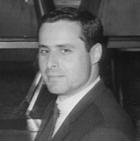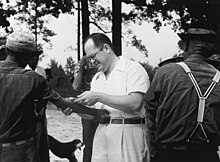Peter Buxtun
Peter Buxtun (sometimes also Peter Buxton ; born 1937 in Prague ) is an American social worker and former employee of the United States Public Health Service , who became known as a whistleblower because of his publication of the Tuskegee Syphilis Study . The experiment was discontinued after it became public.
Exposure of the Tuskegee Syphilis Study
In 1965, at the age of 27, Buxtun worked as a social worker and epidemiologist in San Francisco before he was hired by the US Public Health Service as an interviewer for patients with sexually transmitted diseases . While at work, he learned from colleagues about the Tuskegee Syphilis Study by the medical doctor John Charles Cutler , which examined the consequences of untreated syphilis infections on nearly 400 infected African-American land tenants in Tuskegee , Alabama .
In November 1966, Buxtun officially protested against the study for ethical reasons at the department for venereal diseases of his agency. The protest was rejected because the study was not yet finished. In November 1968 he lodged another protest, which was also rejected as meaningless.
In 1972 he finally informed the journalist Jean Heller of the Washington Evening Star about the study. Heller made the experiment public in an article published on July 25, 1972; the very next day the subject was the cover story of the New York Times . Subsequently, Senator Edward Kennedy convened congressional hearings at which Buxtun and officials from the United States Department of Health and Human Services were heard. The study was discontinued shortly afterwards based on the results.
In May 1999, Buxtun took part in the inauguration of a memory center with a public exhibition on the experiment in Tuskegee.
literature
- Susan Reverby: Examining Tuskegee: The Infamous Syphilis Study and Its Legacy. The University of North Carolina Press, October 2009; ISBN 978-0-8078-3310-0
supporting documents
- ↑ Donald Granberg, John F. Galliher: A most human enterprise: controversies in the social sciences. Lexington Books, Lanham 2010, p. 3.
- ^ A b Jean Heller: The legacy of Tuskegee . In: St Petersburg Times , July 20, 1997, p. 1D.
- ↑ Allen Rubin, Babbie, Earl R .: Research Methods for Social Work . Thomson Wadsworth, 2005, ISBN 978-0-534-62109-4 , p. 70.
- ↑ Stephen B., PhD Thomas, Quinn, Sandra Crouse, MEd: The Tuskegee Syphilis Study, 1932 to 1972: Implications for HIV Education and AIDS Risk Education Programs in the Black Community. Archived from the original on July 1, 2007. Info: The archive link was used automatically and not yet checked. Please check the original and archive link according to the instructions and then remove this notice. In: American Public Health Association (Ed.): American Journal of Public Health . 81, No. 11, November 1991, ISSN 1541-0048 , pp. 1498-1505. doi : 10.2105 / AJPH.81.11.1498 . PMID 1951814 . PMC 1405662 (free full text). Retrieved March 6, 2008.
- ↑ Jeff Stryker: Tuskegee's long arm still touches a nerve . In: New York Times , April 13, 1997, p. 4.
- ↑ Center launched as a training tool . In: Associated Press , May 17, 1999.
| personal data | |
|---|---|
| SURNAME | Buxtun, Peter |
| ALTERNATIVE NAMES | Buxton, Peter |
| BRIEF DESCRIPTION | American social worker and whistleblower |
| DATE OF BIRTH | 1937 |
| PLACE OF BIRTH | Prague |

